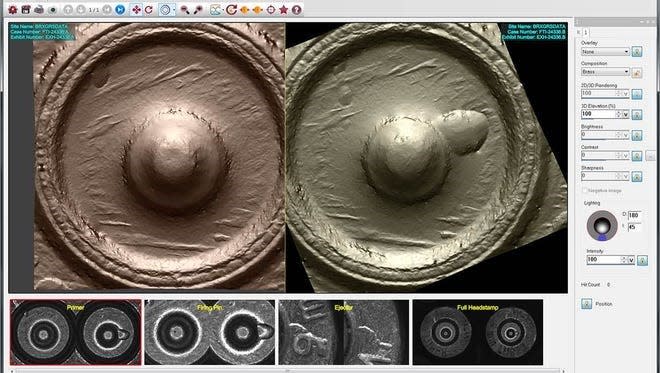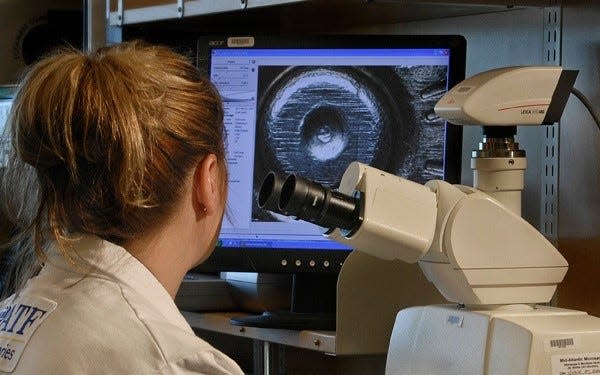See the police tech being used to track guns in Cincinnati
For more than a year, the Cincinnati Police Department has been operating its crime gun intelligence center. The operation uses technology to target violent gun offenders in the city. Here's what goes on inside.
Located on Central Parkway, the building allows Cincinnati police to work directly with the Bureau of Alcohol, Tobacco, Firearms and Explosives and Department of Homeland Security. Currently, 32 Cincinnati officers, seven ATF agents, four Hamilton County sheriff deputies assigned to the ATF task force and one Homeland Security agent are working there.
Together, they can track guns as they are used throughout the city even before the gun has been recovered. They can process evidence such as guns and shell casings to obtain fingerprints and DNA. Analysts connect the guns to people and map out how those people are connected to each other.
From January 2022 through April 2023, the unit made 506 arrests, according to Cincinnati police Lt. Eric Vogelpohl who is among the leadership at the center.
The Enquirer published an in-depth report in November on a series of cases that were linked together through the work happening at the crime gun intelligence center. In the end, a group was linked to five homicides and dozens of murders.
The partnership between federal agents and local law enforcement means that charges can be filed at the state or federal level depending on what is more appropriate.
More and more Glock switches, the small devices that turn a Glock handgun into a fully automatic machine gun, are being found in Cincinnati. With the ATF presence here at the crime gun intelligence center, agents have filed federal charges in several cases involving the devices resulting in multiple convictions.
What is the National Integrated Ballistic Information Network?
Since 2016, Cincinnati police have been utilizing the ATF's National Integrated Ballistic Information Network, a database of shell casings that new evidence can be compared against. The technology is one of the primary tools used at the intelligence center.
What is a shell casing fingerprint?
Using 3D digital imaging, the system can identify the unique "fingerprint" each gun leaves on a shell casing. When a bullet is fired from a semi-automatic firearm, the bolt face, firing pin and extractor all leave marks of the brass case and primer.

Therefore, two shell casings collected in different places and at different times can be linked to the same gun, even if that gun is not the possession of law enforcement, the ATF states. When a gun is recovered, a round can be fired and the shell casing can be entered into the system to link that weapon to other shootings.
By the middle of 2023, the Cincinnati Crime Gun Intelligence Center had processed 5,401 shell casings, and 1,291 recovered guns were linked to multiple incidents, Vogelpohl said.
In order to collect as much data for the ballistic information network as possible, Cincinnati police and the Crime Gun Intelligence Center have instituted policies to collect as many shell casings as possible.
What is ShotSpotter?
Large swaths of Cincinnati are covered by the ShotSpotter gunshot detection system.
The ShotSpotter system alerts police to shootings even if no one places a call to 911. When a gun is fired outdoors, the system triangulates where it happened. Even if no one is shot, Cincinnati police respond to all ShotSpotter alerts to search for shell casings. The crime gun intelligence center unit will even send trained dogs to scenes to sniff out shell casings when officers can't find anything.
All of these shell casings are collected to create a map of how guns are used throughout the city.
In 2022, there were over 3,000 ShotSpotter activations in Cincinnati. Officials at the intelligence center said that a majority of the evidence collected from these incidents gets linked to other shootings already in the ballistic information network.

Cincinnati center gets national attention
The number of Crime Gun Intelligence Centers has more than doubled in 2023. There are now 54 operating in the U.S. Cincinnati's center was the first in Ohio. The leaders at the center credit the strong relationships between the police department and the ATF for its success. If either agency gets too territorial or controlling, it can cause problems, the leaders said.
Due to the success of Cincinnati's center, the Regional Crime Gun Intelligence Center Multisite Training Conference was held here in August. Law enforcement from throughout the region came to see the work that was being done in the city.
Vogelpohl said the approach the center is using is having a serious impact on crime while remaining data-driven.
"CGIC enables the officers to perform comprehensive bias-free investigations, free from charges or accusations of conducting race-based investigations," he said. "The officers follow the evidence which leads them to a shooter or group of shooters who become the sole focus of our investigations. The goal is to identify and stop the trigger pullers in the city."
This article originally appeared on Cincinnati Enquirer: Take a look at the police tech being used to track guns in Cincinnati
